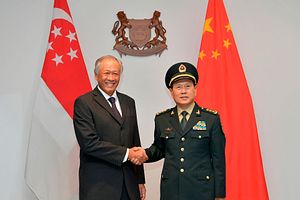On May 29, Singapore and China officially disclosed that they would move forward on stepping up defense ties through steps that would be formalized through a revised bilateral agreement by the end of this year. While specifics are still being worked out by both sides, the development nonetheless reinforced ongoing efforts to strengthen relations in the security domain even amid continued differences between them that have manifested over the past few years.
As I have observed before in these pages and elsewhere, the contemporary Singapore-China formal diplomatic relationship – which began only in 1990 despite relations that had been at play much earlier – has also more recently grown to have a defense component as well. The range of engagements, which include visits, exchanges, port calls, and exercises, were formalized in an agreement signed by the two sides in 2008 known as the Agreement on Defense Exchanges and Security Cooperation (ADESC).
Despite challenges in the China-Singapore relationship in recent years – as manifested by incidents such as the seizure of Singapore military vehicles following an exercise with Taiwan in November 2016 as well as the focus on concerning aspects of Chinese presence in the country such as influence operations – both sides have continued to try to advance ties on this front within limits as part of effort to stabilize ties. That has continued on over the past year or so, both in terms of bilateral interactions as well as wider regional activities. To take just one example, during Singapore’s holding of the annual ASEAN chairmanship last year, it helped usher in the holding of the first-ever ASEAN-China maritime exercise, which has held in October. Singapore also participated in the 2019 Southeast-Asia China Maritime Exercise that was held alongside the People’s Liberation Army Navy’s (PLAN’s) 70th anniversary International Fleet Review in April.
This week, the defense aspect of the relationship was in the headlines again with the visit of Chinese Defense Minister Wei Fenghe. Wei, who was in Singapore to attend the Shangri-La Dialogue over the weekend, held meetings with Singapore Defense Minister Ng Eng Hen along with other top officials including Prime Minister Lee Hsien Loong, Deputy Prime Minister and Minister for Finance Heng Swee Keat, Senior Minister and Coordinating Minister for National Security Teo Chee Hean.
On the defense side, while Wei and Ng discussed a range of issues – including upcoming engagements as well as issues such as confidence-building – the most significant outcome that was publicly announced following the meeting was that both countries would be deepening defense ties. Per Singapore’s defense ministry, the revised ADESC between the two sides, expected to be signed by both ministers later this year, would include the establishment of frequent high-level dialogues, new arrangements for services-to-services cooperation, academic and think-tank exchanges, as well as an increase in the scale of existing bilateral exercises.
The agreement by both sides to boost defense collaboration, while not surprising, is not without significance when understood within the context of trends already underway. Generally, it is consistent with China’s longstanding interest in boosting security ties with Southeast Asian states as part of deepening wider relations, and the growing willingness among some regional countries to pursue a relatively greater degree of defense collaboration with Beijing – albeit within limits – in recognition of its rising profile and in spite of its demonstrated assertiveness. More specifically, it reflects Singapore’s efforts to stabilize its relationship with China and calibrate its alignments more generally – including with countries such as the United States, a longtime strategic partner – as the country navigates a range of broader challenges at home and abroad and gradually goes through a leadership transition away from Lee Hsien Loong.
Nonetheless, it is important not to overstate the impact of what both sides have publicly announced. The devil is often in the details with such agreements, and we have yet to see the specifics that will be evident once the pact is actually signed and then implemented. As of now, while the progress cited is not insignificant, the areas mentioned, such as exchanges, dialogues, and scaling up existing exercises, constitute at best modest gains considering that the two countries are a decade into formalized defense collaboration. Furthermore, if anything, some of the tensions on issues that have played out in China-Singapore ties over the past few years, from the South China Sea to Chinese influence operations, have only reinforced to Singapore and other regional countries the necessity of pursuing collaboration with Beijing on aspects such as defense with one eye open.
Given all this, the true significance of what both sides have worked out will become clearer once specific engagements play out during the rest of 2019 and into 2020, including the actual signing of the revised pact and the next iteration of an exercise between them, Exercise Maritime Cooperation, that is expected to be held in 2020 following the previous iteration in 2015. Paying attention to those specifics will be important to assess how the rhetoric of increased defense cooperation is actually translating into reality in the coming years.
































